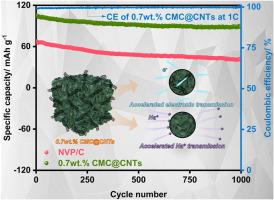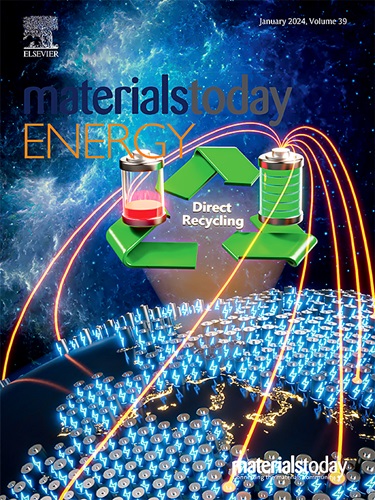In-situ construction of porous carbon substrate from sodium carboxymethyl cellulose boosting ultra-long lifespan for Na3V2(PO4)3 cathode material
IF 8.6
2区 材料科学
Q1 CHEMISTRY, PHYSICAL
引用次数: 0
Abstract
NaV(PO) (trisodium divanadium (III) tris (orthophosphate [NVP]), the cathode material for sodium ion batteries, faces several challenges, such as lower intrinsic electronic and ionic conductivities, which hinder its commercial viability. In this work, NVP system is modified by introducing sodium carboxymethyl cellulose (Na CMC) to achieve triple modification effects: sodium-rich, cross-linked carbon coating network, and carbon layer surface modification. Meanwhile, CMC, as a porous carbon substrate with large pores, provides a fast migration channel for Na. Similarly, carbon nanotubes (CNTs) grown from the active particles become the connecting carriers between the active particles, thus effectively improving the electron transport. Notably, the scanning electron microscopy (SEM) and transmission electron microscopy (TEM) images after cycling verify the stabilized porous structure of the NaV(PO)/C@0.7wt.%CMC@CNTs (0.7wt.%CMC@CNTs) composite. Distinctively, the modified 0.7wt.%CMC@CNTs reveals a capacity of 111.4 mAh/g at 0.1 C. It submits a high value of 105.0 mAh/g at 1 C with a capacity retention rate of 84.10% after 1,000 cycles. Even at 15 C, it still releases 86.6 mAh/g with a low capacity decay rate of 0.0230% per cycle after 3,600 cycles. Notably, its capacity retention reaches an astonishing 96.09% after 13,000 cycles at an ultra-high rate of 80 C.

利用羧甲基纤维素钠原位构建多孔碳衬底,提高 Na3V2(PO4)3 阴极材料的超长寿命
钠离子电池的阴极材料 NaV(PO)(正磷酸三钒三钠盐 [NVP])面临着一些挑战,如较低的固有电子和离子电导率,这阻碍了其商业可行性。在这项工作中,通过引入羧甲基纤维素钠(Na CMC)对 NVP 系统进行改性,实现了三重改性效果:富钠、交联碳涂层网络和碳层表面改性。同时,CMC 作为一种具有大孔的多孔碳基质,可为 Na 提供快速迁移通道。同样,从活性颗粒中生长出来的碳纳米管(CNT)成为活性颗粒之间的连接载体,从而有效改善了电子传输。值得注意的是,循环后的扫描电子显微镜(SEM)和透射电子显微镜(TEM)图像验证了 NaV(PO)/C@0.7wt.%CMC@CNTs (0.7wt.%CMC@CNTs) 复合材料稳定的多孔结构。经改性的 0.7wt.%CMC@CNTs 在 0.1 摄氏度时显示出 111.4 mAh/g 的容量,在 1 摄氏度时达到 105.0 mAh/g 的高值,循环 1,000 次后容量保持率为 84.10%。即使在 15 摄氏度时,它仍能释放出 86.6 mAh/g,在 3,600 次循环后,每次循环的容量衰减率仅为 0.0230%。值得注意的是,在 80 摄氏度的超高温度下,经过 13,000 次循环后,其容量保持率达到了惊人的 96.09%。
本文章由计算机程序翻译,如有差异,请以英文原文为准。
求助全文
约1分钟内获得全文
求助全文
来源期刊

Materials Today Energy
Materials Science-Materials Science (miscellaneous)
CiteScore
15.10
自引率
7.50%
发文量
291
审稿时长
15 days
期刊介绍:
Materials Today Energy is a multi-disciplinary, rapid-publication journal focused on all aspects of materials for energy.
Materials Today Energy provides a forum for the discussion of high quality research that is helping define the inclusive, growing field of energy materials.
Part of the Materials Today family, Materials Today Energy offers authors rigorous peer review, rapid decisions, and high visibility. The editors welcome comprehensive articles, short communications and reviews on both theoretical and experimental work in relation to energy harvesting, conversion, storage and distribution, on topics including but not limited to:
-Solar energy conversion
-Hydrogen generation
-Photocatalysis
-Thermoelectric materials and devices
-Materials for nuclear energy applications
-Materials for Energy Storage
-Environment protection
-Sustainable and green materials
 求助内容:
求助内容: 应助结果提醒方式:
应助结果提醒方式:


